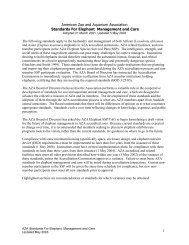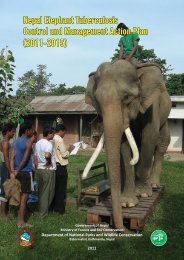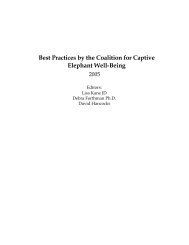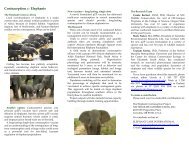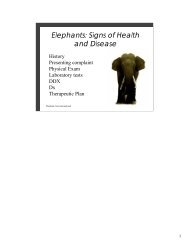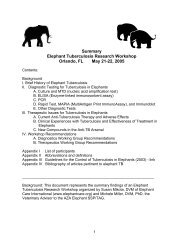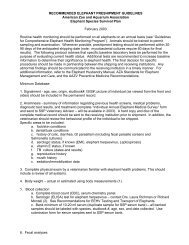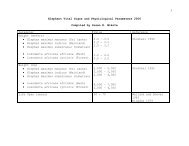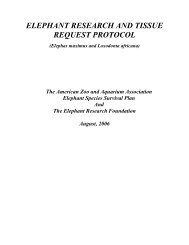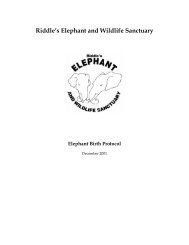Elephants Elephants - Wildpro - Twycross Zoo
Elephants Elephants - Wildpro - Twycross Zoo
Elephants Elephants - Wildpro - Twycross Zoo
- No tags were found...
You also want an ePaper? Increase the reach of your titles
YUMPU automatically turns print PDFs into web optimized ePapers that Google loves.
half the shoulder height distance (Kurt 1974). However, these ratios are notalways as accurate for captive zoo elephants which are frequently overweight(see Section 3).2.3 PhysiologyA comprehensive account of the elephant’s physiology is outside of the scopeof this document. However, due to their immediate relevance to theveterinary management of elephants, a few points deserve emphasis.The normal body temperature of the elephant is between 36 and 37 o C.Temperatures of 38 o C or above indicate a fever. As long as acclimatisation isachieved progressively, elephants will adapt to a wide range of environmentaltemperatures. A large mass:surface area ratio helps the elephant to tolerateambient temperatures of 4 o C or even lower, provided sufficient protection isafforded from wind. However, elephants have a limited ability to lose heat,and very high ambient temperatures and/or exposure to direct sunlight canbe problematic. Sweat glands are present throughout the skin, but are few innumber except for immediately above the toenails - thus the elephant relies onheat loss through the ears, sheltering from the hot sun and evaporative lossesfollowing bathing to avoid hypothermia. It is essential to provide shade andwater to bathe in at all times in hot climates.The digestive system of the elephant is similar to that of the domestic horse. Ithas a simple stomach and cellulose digestion takes place through microbialfermentation in the large caecum and colon (and see section 2.7). The liver islarge, and there is no gall bladder. The presence of moderate amounts of sandand stone in the intestinal tract is probably normal. <strong>Elephants</strong> defecate up to20 times daily, with 4 – 6 boluses per defecation. Schmidt (1986) remarks thatelephants fed primarily on hay will have large roughly spherical faecalboluses, composed of what looks like finely chopped hay and have 12-20defecations per day, of 4-6 boluses per defecation (and see Section 2.7).The resting heart rate of a standing adult elephant is between 30 and 40 beatsper minute (bpm) increasing by up to 25% when the animal lies in lateralrecumbency. (Healthy elephants in captivity can stand for long periods andgenerally do not lie down for any length of time during the day). Lateralrecumbency also leads to increases in arterial blood pressure and a decrease inarterial partial pressure of oxygen (PaO 2) (Honeyman et al 1992), thus therecumbent elephant may be at risk of developing hypoxemia andhypertension. However, elephant blood has a greater affinity for oxygen thanthat of other mammals.<strong>Elephants</strong> are basically nose breathers – in other words, 70 % of their air intakeis via the trunk. The lungs are attached to the chest wall by fibrous connectivetissue which effectively eliminates any pleural space. This has been taken bysome to indicate that elephants rely more on diaphragmatic movement forrespiration than on costal movements (Todd 1913). Respiratory rates of adultelephants are generally between 4–6 per minute, rising noticeably whenexcited. Sternal recumbency can be dangerous especially in tired animals(Namboodiri 1997).14




